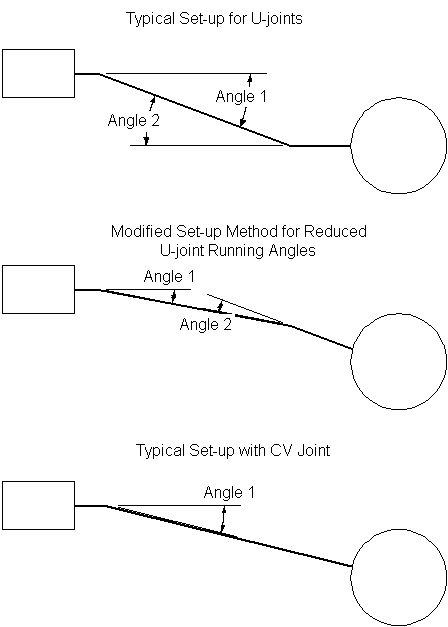3 Ways to Correct Driveline Angles
There are three pratical ways to solve dirveline vibrations. They are: u-joint
with opposite angle in the top picture (most common), u-joint with same angle,
middle picture, which is less common and cv-joint on the bottom picture which
is quite common too.

Pros and Cons of each method:
For the Toyota set-up with Old Man Emu Leaf Springs:
Just by bolting the OME springs on and do nothing, the front u-joint angle
would be 10.5 degree and the rear would be 6.9 degree. This is a problem because
with torque at the wheel, the rear angle would be 6.9 degree - 3 degree(reaction
due to torque load) = 3.9 degree. 10.5 degree in front and 3.9 degree is not
good. That is a 6.6 degrees difference
in bent of the u-joints. This is too much. Some noticable fault is when lifting
the gas pedel going downhill at about 75 to 80mph there is some loud gear
noise. There is gear-wining noise at all slow speeds. If this were a weekend
play truck, this would be all right. As a daily driver, this noise is not
acceptable. There is too much stress on the drivetrain. These gear noise and
whine gets irritating in a long drive. I would not go over 65mph because of
the noise.
I tried rotating the rear axel downward so that the rear and front would
have the same angle. But by rotating the rear axel, the end point of the driveshaft
would be lower also. This increases the front u-joint angle to 12 degree.
The rear would be 12.5 degrees. 12
degrees is a little high for a u-joint angle. Although the output of the driveshaft
is rotating at a constant rate, the shaft itself is speeding up and slowing
down too much. This caused vibration
at high speed. The axel was actually had a .5 degree downward bias from the
transfer case, so when the axel wind up during acceleration, it would be aligned.
This took out more vibration. However, I felt there was still some vibration
in the driveline. I decided to put the heavy short leaf on the spring pack,
which was taken out initially for flexibility, to make the spring the way
it was designed. This final step took out almost all of the vibration.
This is probably because the axel does not rotate as much with the
stiffer spring and cause u-joint misalignments.
However, there is still a persistent vibration that would not go away.
I spent more time trying different spring and shim combination. I tried pointing
the pinion flange at the transfer case with a u-joint at the transfer case.
This helped some, but there was still vibration at high speed especially decelerating
at high speed. My final conclusion is that I need a constant velocity joint
driveshaft similar to the front driveshaft. Using Auto-Cadd, I found that
rotating the axel 4 degrees up would give a 2.8-degree bias on the back u-joint.
With acceleration, that 2.8 degree angle should drop down to 0 hopefully because
of torque on the axel housing during acceleration. I used Auto-Cadd to figure the geometry out because I am tired of
the trial and error method. I got a brand new cv shaft from Inland
Empire Driveline Services. They bought a large batch of Toyota cv shaft
long time ago, and still had a couple left. After paying $480, I installed
the new shaft and a 4-degree shim. That took out all the vibrations

In the decision on CV driveshaft, there are two options. Use a cv-joint on
one end of the driveshaft which is common practice, or to use 2 cv-joints
at both ends of the driveshaft. If I use one cv-joint, I would have to rotate
the axel up so that it point at the transfer case. This would require a 3
or 4 degree shim. This slight amount of rotation should not cause any oil
starvation problems. The other option is to use two cv-joints one at each
end of the driveshaft. This will give a smooth ride no matter what angles
each joint is at. I chose the one cv-joint for cost savings.
After the installation of the CV joint, the ride was as smooth as it
was before the lift. In all, I had
to install and remove the axel many times trying different solution and taking
out leaves to come to an acceptable solution.
The conclusion is that even with a 2.5" lift, a CV driveshaft is absolutely
necessary if you want the truck to be durable. Without the cv shaft, the u-joint
angles are running too high causing shutters and gear noise. For the most
part, since the vibration is torsional, and the engine and transmission is
mounted on rubber mounts, you will not feel anything other than a slight annoyance.
It is easy to ignore that slight vibration. However, that shutter is doing
harm to the gears and bearings throughout the driveline. If you intend to
sell the vehicle after a year or two, or if the vehicle is only used on the
weekend, then there is no point spending the extra money on a cv shaft. However,
if the vehicle is a daily driver, then a cv shaft is a must. That slight vibration
becomes a major annoyance on long trips especially when you know you are destroying
the vehicle as you are driving it. I hate to be faced with a large repair
bill time and time again because the drivetrain was not set up correctly in
the first place. With the CV joint and the 4-degree rotation of the axel,
the ride is absolutely smooth. That is the way that a car should drive in
the first place.
Lots of technical information on u-joint and CV-joint:
On to part 2.
Is
a constant velocity joint really, really constant? It is 99 point nine and
a half percent constant, but not quite...

